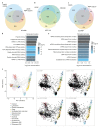Comprehensive identification of RNA-protein interactions in any organism using orthogonal organic phase separation (OOPS)
- PMID: 30607034
- PMCID: PMC6591131
- DOI: 10.1038/s41587-018-0001-2
Comprehensive identification of RNA-protein interactions in any organism using orthogonal organic phase separation (OOPS)
Erratum in
-
Author Correction: Comprehensive identification of RNA-protein interactions in any organism using orthogonal organic phase separation (OOPS).Nat Biotechnol. 2019 Jun;37(6):692. doi: 10.1038/s41587-019-0161-8. Nat Biotechnol. 2019. PMID: 31123356
Abstract
Existing high-throughput methods to identify RNA-binding proteins (RBPs) are based on capture of polyadenylated RNAs and cannot recover proteins that interact with nonadenylated RNAs, including long noncoding RNA, pre-mRNAs and bacterial RNAs. We present orthogonal organic phase separation (OOPS), which does not require molecular tagging or capture of polyadenylated RNA, and apply it to recover cross-linked protein-RNA and free protein, or protein-bound RNA and free RNA, in an unbiased way. We validated OOPS in HEK293, U2OS and MCF10A human cell lines, and show that 96% of proteins recovered were bound to RNA. We show that all long RNAs can be cross-linked to proteins, and recovered 1,838 RBPs, including 926 putative novel RBPs. OOPS is approximately 100-fold more efficient than existing methods and can enable analyses of dynamic RNA-protein interactions. We also characterize dynamic changes in RNA-protein interactions in mammalian cells following nocodazole arrest, and present a bacterial RNA-interactome for Escherichia coli. OOPS is compatible with downstream proteomics and RNA sequencing, and can be applied in any organism.
Conflict of interest statement
The authors declare no competing financial interests.
Figures






Similar articles
-
Efficient recovery of the RNA-bound proteome and protein-bound transcriptome using phase separation (OOPS).Nat Protoc. 2020 Aug;15(8):2568-2588. doi: 10.1038/s41596-020-0344-2. Epub 2020 Jul 10. Nat Protoc. 2020. PMID: 32651564 Free PMC article.
-
Transcriptome-Wide Identification of Coding and Noncoding RNA-Binding Proteins Defines the Comprehensive RNA Interactome of Leishmania mexicana.Microbiol Spectr. 2022 Feb 23;10(1):e0242221. doi: 10.1128/spectrum.02422-21. Epub 2022 Feb 9. Microbiol Spectr. 2022. PMID: 35138191 Free PMC article.
-
Comparative analysis of RNA-binding proteomes under Arabidopsis thaliana-Pst DC3000-PAMP interaction by orthogonal organic phase separation.Int J Biol Macromol. 2020 Oct 1;160:47-54. doi: 10.1016/j.ijbiomac.2020.05.164. Epub 2020 May 23. Int J Biol Macromol. 2020. PMID: 32454107
-
Organic phase separation opens up new opportunities to interrogate the RNA-binding proteome.Curr Opin Chem Biol. 2020 Feb;54:70-75. doi: 10.1016/j.cbpa.2020.01.009. Epub 2020 Mar 1. Curr Opin Chem Biol. 2020. PMID: 32131038 Review.
-
Single and Combined Methods to Specifically or Bulk-Purify RNA-Protein Complexes.Biomolecules. 2020 Aug 7;10(8):1160. doi: 10.3390/biom10081160. Biomolecules. 2020. PMID: 32784769 Free PMC article. Review.
Cited by
-
A multi-channel in situ light scattering instrument utilized for monitoring protein aggregation and liquid dense cluster formation.Heliyon. 2019 Dec 13;5(12):e03016. doi: 10.1016/j.heliyon.2019.e03016. eCollection 2019 Dec. Heliyon. 2019. PMID: 31886430 Free PMC article.
-
Characterization of long non-coding RNA and messenger RNA profiles in laryngeal cancer by weighted gene co-expression network analysis.Aging (Albany NY). 2019 Nov 18;11(22):10074-10099. doi: 10.18632/aging.102419. Epub 2019 Nov 18. Aging (Albany NY). 2019. PMID: 31739287 Free PMC article.
-
Investigating the Prevalence of RNA-Binding Metabolic Enzymes in E. coli.Int J Mol Sci. 2023 Jul 16;24(14):11536. doi: 10.3390/ijms241411536. Int J Mol Sci. 2023. PMID: 37511294 Free PMC article.
-
Biotin proximity tagging favours unfolded proteins and enables the study of intrinsically disordered regions.Commun Biol. 2020 Jan 22;3(1):38. doi: 10.1038/s42003-020-0758-y. Commun Biol. 2020. PMID: 31969649 Free PMC article.
-
The impact of RNA binding proteins and the associated long non-coding RNAs in the TCA cycle on cancer pathogenesis.RNA Biol. 2023 Jan;20(1):223-234. doi: 10.1080/15476286.2023.2216562. RNA Biol. 2023. PMID: 37221841 Free PMC article. Review.
References
-
- Müller-Mcnicoll M, Neugebauer KM. How cells get the message: Dynamic assembly and function of mRNA-protein complexes. RNA Biol. 2013;14:275–287. - PubMed
-
- Huntzinger E, Izaurralde E. Gene silencing by microRNAs: contributions of translational repression and mRNA decay. Nat Rev Genet. 2011;12:99–110. - PubMed
Publication types
MeSH terms
Substances
Grants and funding
LinkOut - more resources
Full Text Sources
Other Literature Sources
Molecular Biology Databases

